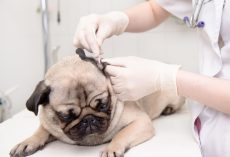Not matter the pup you are probably going to find some physical issues with any dog breed. Pugs, because of their unique characteristics and breeding history, can be on the higher spectrum of medical issues so potential pug owners beware!
1. Luxating Patella: Commonly referred to as “trick knees”, Luxating Patella is fairly common in Pugs, and other breeds of small dogs. In simple terms, it is the dislocation of the small movable bone in the knee called the Patella, from the femur where it is normally held in place by ligaments.
Keep in mind as well that a Pug diagnosed with Luxating Patella may or may never have a problem requiring surgery. Some Pugs can and do live their entire lives with Luxating Patella trouble free, others require surgery.
2. Progressive Retinal Atrophy: Essentially, PRA is the degeneration of the vessels around the retina. It usually begins with night blindness in younger dogs, and their vision deteriorates progressively leading to blindness.
3. Pigmentary Keratitis: The deposit of pigment on the white surface of the eyes, PK is the result of many factors that either irritate or inflame the cornea.
4. Elongated Soft Palate: Common in short muzzled breeds, ESP is the obstruction of the dogs’ airways. ESP can be corrected through surgery.
5. Stenotic Nares: Is a birth defect found in breeds with short noses including the Pug and is essentially overly soft nasal tissue. When a dog with overly soft nasal tissues breathes, their nostrils collapse, leaving them to breathe through their mouths to get the necessary oxygen. SN can be corrected through surgery.
6. Pug Dog Encephalitis: Commonly called PDE, Pug Dog Encephalitis is as the name implies, unique to Pugs. Little, if anything is known of the causes of PDE, which is essentially an inflammation of the brain. PDE tends to affect young to middle aged Pugs and feature seizure as it’s primary symptom.
We are not saying it is all bad things for all pugs but, as a conscientious dog owner, you need to watch for visible problems and do not hesitate to take your pup in for yearly physicals. You may not see it but an illness could be waiting in the wings.
If you would like to learn essential information concerning your pug go to Pug Village.










Amy Dinger
- Edit
I like this article. Its honest. I thought it would be another stupid “6 things….. 1 they are cute. 2 did we mention they are cute? 3…..”